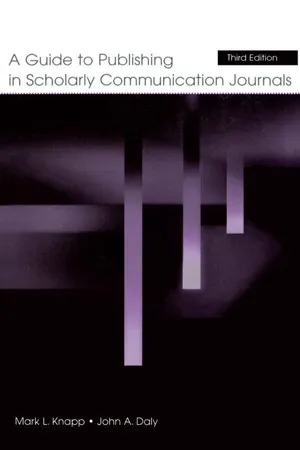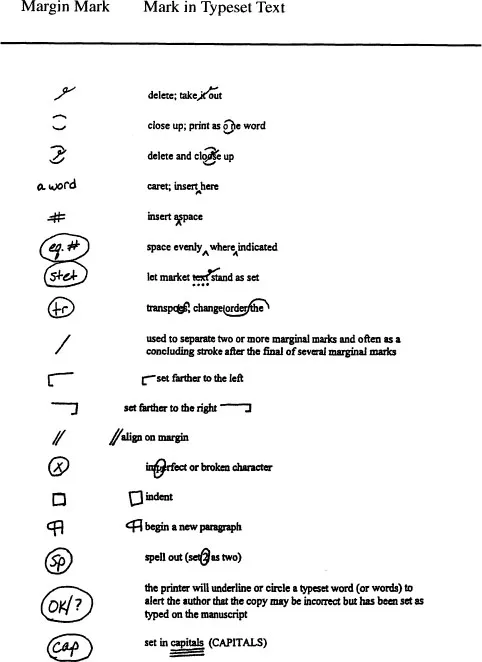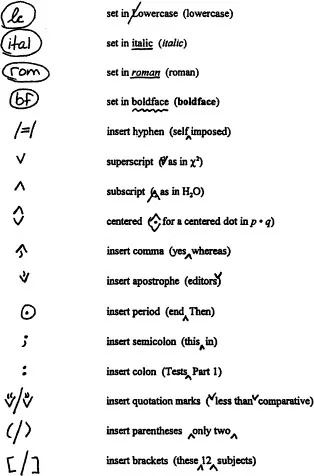![]()
APPENDIX A
EXAMPLE OF AUTHOR COVER LETTER
January 12, 2003
JANE Q. EDITOR
Journal of __________
State University of Wherever
Department of Communication Studies
Anywhere, USA
Dear Dr.__________:
Enclosed you will find four copies of a manuscript entitled, “An Analysis of Comforting Messages Communicated to Owners of Recently Deceased Pets” which my coauthor and I would like to submit to the Journal of __________for review and possible publication.
I look forward to hearing from you.
Sincerely,
John Q. Author
mailing address
phone number
email address
![]()
APPENDIX B
EXAMPLE OF MANUSCRIPT REVIEW FORM
Journal of _________
Manuscript Review Form
MSTitle:____________________________________
MS#___________Reviewer: ____________________
Signature:__________________________________
Recommendation (check one):
___________Publish as is
___________Publish with minor revisions indicated below
___________Publish with major revisions indicated below
___________Revise and resubmit
___________Submit to another journal, e.g.,
___________Reject
Manuscript Rating (5 = average quality):
Overall Impression of Quality | Importance of the Researchable Idea |
Low 1 2 3 4 5 6 7 8 9 High | Low 1 2 3 4 5 6 7 8 9 High |
Methodology | Style |
Unclear 1 2 3 4 5 6 7 8 9 Clear | Weak 1 2 3 4 5 6 7 8 9 Strong |
Comments to the Author:
(Please indicate on a separate sheet your detailed and candid opinion regarding this manuscript.)
Return to:
Dr. John Q. Editor
Dept of Communication
General University
Anywhere, USA
![]()
APPENDIX C
EXAMPLE OF A CONSTRUCTIVE CRITIQUE
Reviewof MS #____________
I am generally favorably disposed to the publication of manuscript #2043 although there are some specific and, I believe, serious issues that the authors must address before I could recommend publication. These issues are outlined below. If the editor concurs with me, I will be happy to review a revised version of this manuscript for publication in________.
I strongly encourage the authors to revise.
Before presenting the negative criticisms, let me mention, briefly, the positive attributes of this manuscript. It is well-written and reflects considerable knowledge of the relevant literature. The phenomena explored are basic to the field of communication, although perhaps not too flashy. By and large, the theorizing is tightly reasoned (exceptions noted below). The methodological criticisms of previous literature, particularly the factor analytic studies, reflect some sophistication. All in all it is a good paper, however, it is marred by weaknesses that require revision.
1. The definitions of the basic variables in the model are a bit loose. For instance, P (participation) is “each person’s share of the activity and talking in the group” (p. 2). ‘Activity’ is hardly a precise term. (Is nonverbal activity included or just verbal activity?) Operationally, the authors permit anything from the number of “social acts” to total duration of talk, to number of words/discussions among peer reports of talkativeness as indices of P. This appears to be pretty fuzzy. It could be tidied up by reporting the relatively strong correlations that exist in the literature among objective measures of verbal output. I do not know how self- or peer reports correlated with these objective measures. Perhaps the authors do. At any rate, the operational indicators of P need to be shown to represent a single conceptual domain with empirical evidence.
Similar problems plague the E (evaluation) variable. Here the authors define E in terms of an individual’s “positive or negative feelings toward people or their behavior” (p. 2). Feelings about what? Their actions? Their personalities? Their abilities? Their contributions? It seems to me that those do not present a single conceptual domain. If not, then there exists a set of curves (as in Fig. 3) with the same P as the x-axis and different Es as the y-axis. If so, does the observer have to make all the Es and Ps fit the equilibrium points? What about potential trade-offs between types of evaluation? Might I increase my evaluation of someone’s abilities and decrease personal liking to bring both Es into equilibrium? If the authors cannot demonstrate the conceptual and empirical coherence of the E dimension, these are some of the questions they should address, at least in footnote format.
2. There appears to be an inconsistency in the authors’ use of evidence. They argue that low or zero correlations should be expected in factor analytic studies of the relationship between P and E. This is a reasonable conclusion given Figure 3. But if this is true, why did the studies reported on pp 7–10 indicate a positive linear relationship? If I could run a regression line through either Figures 2 or 3, I should get a near zero or negative beta coefficient. Why, then, did all those studies reveal a moderately strong positive relationship? This apparent contradiction needs to be resolved.
I believe that there is an easy resolution, if one will grant that the P-axis has a probability distribution laid on it such that the extreme ends of the axis are very far out on the tails of this distribution. In effect, while we have words to describe people who are so talkative as to be negatively evaluated (Figure 2), we simply do not find people who fit those descriptions very often. As a consequence, we find few data points in the extreme ends of the P-axis, and its middle range (15%–55% perhaps) defines the shape of the regression line of E regressed on P. The authors might consider this explanation of the apparent contradiction noted above. Should they adopt it, they should consider what it might do to the practical significance of their claims.
3. The rationale and evidence supporting the dynamic equilibrium portion of the theory are weak. The hypothesis that individuals attempt to force others to fit their own view of the P-E relationship is an intriguing one—which I find to be plausible. On the other hand, the plausibility of that such improvement might take—one theoretical and one empirical. The theoretical improvement centers on a gap in the current formulation. On p. 17 the authors suggest that the mechanism, causing observers to seek equilibrium between actual P and actual E and expected versions of both is “a process similar to those posited by dissonance or balance theory [sic]. “On p. 19 they argue that departures from the expected P-E curve are “motivating.” What is the nature of this motivation? If such departures are simply dissonance producing, the authors have inherited a large body of literature, replete with controversies, addressing the presence, absence or contingent factors influencing dissonance reduction. I can’t figure out how the balance theory option would fit in, Perhaps the authors could enlighten me. Regardless, my point is that there is a gap in theoretical coverage that demands attention. I can see no reason to accept an equilibrium hypothesis unless the authors can give me a reason for accepting equilibrium to exist.
The empirical move that the authors might make to strengthen this section is quite direct. They currently have very little data to support the equilibrium component of their theory. Either they need to get more from reviews of their literature or amplify more on what they have (cited on p. 21 but blanked out in my copy), or report the results of a pilot test (this is the best option; a full-fledged study doesn’t seem necessary if the other changes mentioned above are undertaken) or all three.
As I noted at the beginning of my critique, I am positively disposed toward this piece. I have raised no objection that I believe cannot be overcome by the authors in some fashion. I am even willing to hear counterarguments on my criticism, but until my objections are circumvented in some fashion I am unwilling to recommend publication.
PS: I have made some detailed comments in the margins of the manuscript. Please forward these to the authors. They cover stylistic and minor substantive issues that have not been addressed in my review.
![]()
APPENDIX D
STANDARD PROOFREADER MARKS
PROOFREADERS MARKS*
*Authors, editors, and printers use proofreaders marks to indicate changes on printed proofs. Theses standard marks are used in pairs, one in the text where the change is to be made and one in the margin closest to the change.
![]()
APPENDIX E
EXAMPLE OF A TYPICAL JOURNAL ASSIGNMENT OF COPYRIGHT FORM
Human Communication Research | Oxford University Press |
Copyright Assignment Form | Journals Department |
| 2001 Evans Road |
Sponsor: International Communication Assn. | Cary, NC 27513, USA |
Your paper has been accepted for publication in Human Communication Research (the Journal). Please Read this Agreement carefully, sign where appropriate, and return the form to the journal Editor (at the address below). Please note that all authors must sign the Agreement before your submission can be published You may photocopy the form to distribute to co-authors.
Assignment of Copyright
Title of Article ___________________________________________
To be completed by the copyright holder:
I attest that I am the author of this material and that it is an original work not previously published in whole or substantial part; that it is free of plagiarism; and that I have exercised reasonable care to ensure that the material is not inaccurate, libelous, or obscene and that it does not infringe on any copyright, right of privacy, or other right of any third party.
I hereby assign to the International Communication Association the copyright present and future in the above-named article for the legal term of the copyright including all renewals or extensions in all languages throughout the world. The granting of copyright entitles the International Communication Association to publish the material in the Journal and to reproduce the article in any form or medium now or hereafter known throughout the world.
Notwithstanding this grant of rights, I retain the right to use the work I have submitted, without charges, in other publications written or edited by myself, provided that I acknowledge the Journal as the original place of publication and that the Publisher, Oxford University Press, is notified of any prepublication (at the address above). I also retain the right to mount my article on my own personal World Wide Web home page and/or that of my employer’s, provided that I (i) acknowledge the Journal as the original place of publication and the International Communication Association as the copyright owner and (ii) provide electronic links from my article to the Publisher’s home page for the Journal http://www.hcr.oupjournals.org/ and to the International Communication Association’s Web site http://www.icahdg.org.
If I am an employee of the US Government submitting a work of the US Government, insofar as I am able within the constraints of national law, I hereby assign the rig...


